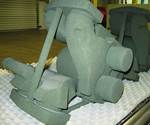Pros and Cons of Making Foundry Patterns Via 3D Printing
A new method of pattern making brings various advantages, not the least of which is expanded design freedom. But 3D printing of patterns is not without trade-offs.
In casting, a mold produces the form of the cast part, while a pattern is used to make the form of this mold. Pattern making is therefore the heart of casting.
Danko Arlington is a company that recently turned to 3D printing—specifically, fused deposition modeling—as a potentially more efficient way to make castings. In a report on the company’s website, company president John Danko discusses the pros and cons of making patterns through additive manufacturing. According to Mr. Danko, those pros and cos include:
Pro
- Design freedom
- Incorporation of intricate features
- Reduced labor
- Speed
- Customers’ high interest in 3D printing
Con
- Equipment cost
- Material cost
- Risk of pattern distortion during printing
- Difficulty repairing or modifying a pattern made through 3D printing
- Potential distortion of 3D printed patterns by hot foundry sand
Read more in Danko Arlington’s report.
Yet another option, instead of 3D printing a pattern, is to 3D print the mold itself directly in sand.
Related Content
-
EOS Works With Phillips Federal, Austal USA to Develop CopperAlloy CuNi30 for US Navy Submarine Industrial Base
Using the copper-nickel alloy in combination with EOS’ platforms offers new design and production capabilities for U.S. Navy submarines, while also enabling the agency to limit global supply chain disruption because parts can be produced regionally, locally and on-demand.
-
BPMI Chooses Velo3D Metal 3D Printing System to Produce Parts for U.S. Naval Nuclear Propulsion Program
The fully integrated 3D printing solution will be operated by ATI in a newly established facility that will provide the U.S. Naval Nuclear Propulsion Program with alternatives to cast parts.
-
Eaton Evaluates Foundry Lab Process as Die Cast Alternative: Aids Prototyping and Supply Chain
Foundry Lab’s digital casting is an additive-enabled process that delivers cast parts. Eaton AM manager describes how near to die casting the process comes, and what promise he sees.















